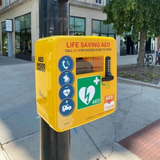Vehicles at Work - What you should Know
If your business deals with heavy goods vehicles (HGVs), construction machinery or any kind of workplace vehicle, then you have a duty to ensure none of the drivers, site workers or any members of the public are put at risk from the work that they do.
Health and safety risks for workplace vehicles can be kept to a minimum by following guidelines that relate to the site, the driver/operator and the vehicle itself.
Site
A carefully designed and well maintained site can greatly reduce the risk of accidents relating to workplace vehicles. Good site design includes a one way system (where possible) to reduce risk of head-on collision and road crossing incidents (pedestrians only need to focus on one stream of traffic).
There should also be segregated areas for workers/pedestrians and vehicles to operate at a safe distance to each other, this includes separate exits and entrances. Where pedestrians and workers need to cross or merge with vehicles, necessary precautions such as drop kerbs, barriers and a safe speed limit should be included in the site design.
Traffic routes through the site should be wide enough for all vehicles to pass through with ease and clearly marked with appropriate signage or markings. They should also, where possible, avoid steep slopes, uneven terrain and sharp corners and bends.
It should also be noted that sites should have appropriate lighting where possible. This means where vehicles manoeuvre, where pedestrians/workers and vehicles merge and where unloading/loading takes place.
Low bridges and tunnels should be properly marked, so should loose surfaces and steep inclines or declines.
Driver
Drivers should have any licenses needed to operate the vehicle they are in control of, no matter how small or seemingly safe the manoeuvre is. They should also be equipped with relevant PPE (personal protective equipment) required by the site they are on, should they need to exit the vehicle.
Drivers must abide by any traffic rules and regulations set by the site they are on. This includes site set speed limits, traffic flow regulations and vehicle operating rules (maximum weight and height, noise levels, pollution).
Many site owners and foremen have the right to refuse entry to any driver deemed unfit to operate a vehicle onsite, or expel those already onsite if they violate regulations.
Vehicles
All onsite vehicles should be capable of safely carrying out the task they are intended for. This includes abiding by the vehicle’s towing weight, lift weight, height restrictions and speed restrictions.
Vehicles should be regularly checked for any damage or wear and tear that could affect use. All damage and wear and tear should be documented and any vehicle deemed not safe to use must not be used until it is repaired or a suitable replacement is found.
Any onsite vehicle leaving the site to join a public road must be road legal and registered with the DVLA before it can legally use public roads.
Ensure that your workplace safe for drivers, workers and pedestrians with our workplace health and safety DVDs, covering lift truck safety, PPE and more.
Recent Posts
-
What is CPR?
Knowing the basics of first aid and how to deliver CPR (cardiopulmonary resuscitation) can make the …17th Nov 2024 -
What is a sudden cardiac arrest (SCA)?
Sudden Cardiac Arrest (SCA) is a critical medical emergency where the heart abruptly ceases to funct …17th Nov 2024 -
Empowering Communities: The Lifesaving Impact of CPR on Restart a Heart Day
Every year, on and around October 16th, an important event takes place - Restart a Heart Day. This a …16th Oct 2023




